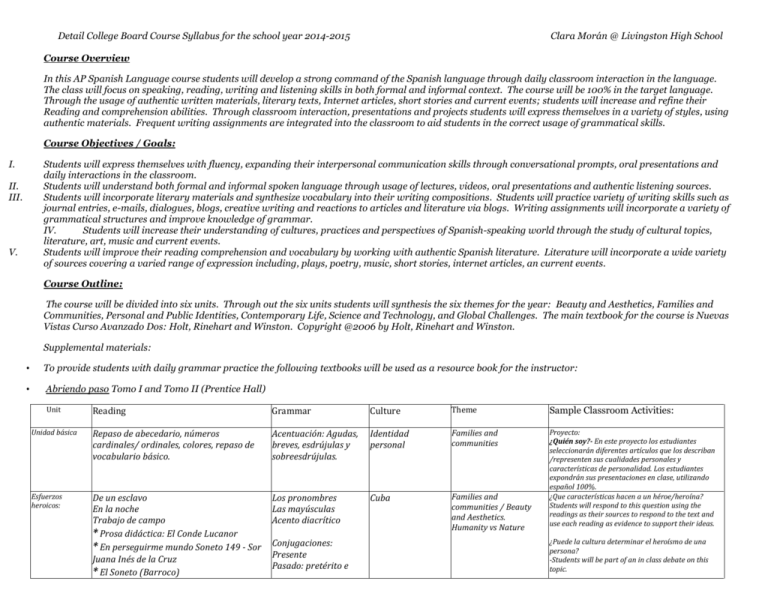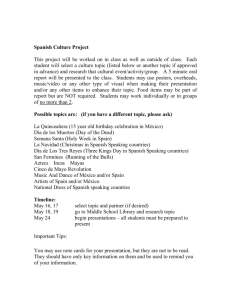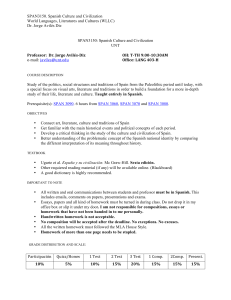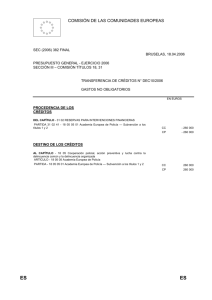File
advertisement

Detail College Board Course Syllabus for the school year 2014-2015 Clara Morán @ Livingston High School Course Overview In this AP Spanish Language course students will develop a strong command of the Spanish language through daily classroom interaction in the language. The class will focus on speaking, reading, writing and listening skills in both formal and informal context. The course will be 100% in the target language. Through the usage of authentic written materials, literary texts, Internet articles, short stories and current events; students will increase and refine their Reading and comprehension abilities. Through classroom interaction, presentations and projects students will express themselves in a variety of styles, using authentic materials. Frequent writing assignments are integrated into the classroom to aid students in the correct usage of grammatical skills. Course Objectives / Goals: I. Students will express themselves with fluency, expanding their interpersonal communication skills through conversational prompts, oral presentations and daily interactions in the classroom. Students will understand both formal and informal spoken language through usage of lectures, videos, oral presentations and authentic listening sources. Students will incorporate literary materials and synthesize vocabulary into their writing compositions. Students will practice variety of writing skills such as journal entries, e-mails, dialogues, blogs, creative writing and reactions to articles and literature via blogs. Writing assignments will incorporate a variety of grammatical structures and improve knowledge of grammar. IV. Students will increase their understanding of cultures, practices and perspectives of Spanish-speaking world through the study of cultural topics, literature, art, music and current events. Students will improve their reading comprehension and vocabulary by working with authentic Spanish literature. Literature will incorporate a wide variety of sources covering a varied range of expression including, plays, poetry, music, short stories, internet articles, an current events. II. III. V. Course Outline: The course will be divided into six units. Through out the six units students will synthesis the six themes for the year: Beauty and Aesthetics, Families and Communities, Personal and Public Identities, Contemporary Life, Science and Technology, and Global Challenges. The main textbook for the course is Nuevas Vistas Curso Avanzado Dos: Holt, Rinehart and Winston. Copyright @2006 by Holt, Rinehart and Winston. Supplemental materials: • To provide students with daily grammar practice the following textbooks will be used as a resource book for the instructor: • Abriendo paso Tomo I and Tomo II (Prentice Hall) Unit Unidad básica Esfuerzos heroicos: Reading Grammar Culture Theme De un esclavo En la noche Trabajo de campo * Prosa didáctica: El Conde Lucanor * En perseguirme mundo Soneto 149 - Sor Juana Inés de la Cruz * El Soneto (Barroco) Los pronombres Las mayúsculas Acento diacrítico Cuba Families and communities / Beauty and Aesthetics. Humanity vs Nature Repaso de abecedario, números cardinales/ ordinales, colores, repaso de vocabulario básico. Acentuación: Agudas, breves, esdrújulas y sobreesdrújulas. Conjugaciones: Presente Pasado: pretérito e Identidad personal Families and communities Sample Classroom Activities: Proyecto: ¿Quién soy?- En este proyecto los estudiantes seleccionarán diferentes artículos que los describan /representen sus cualidades personales y características de personalidad. Los estudiantes expondrán sus presentaciones en clase, utilizando español 100%. ¿Que características hacen a un héroe/heroína? Students will respond to this question using the readings as their sources to respond to the text and use each reading as evidence to support their ideas. ¿Puede la cultura determinar el heroísmo de una persona? -Students will be part of an in class debate on this topic. * Soneto XXIII- Lope de Vega * Soneto XIII – Góngora * Soneto XVII – Quevedo imperfecto (verbos regulares e irregulares) Cadena rota Naranjas Una carta a Dios La muralla La poesía del siglo XIX * Rima XXXIX-Bécquer Yo soy un hombre sincero- José Martí Canción de Otoño en primavera – Rubén Darío De la fiesta del árbol Árbol adentro Paisaje y meciendo Las abejas de bronce Dicen que no hablan las plantas La poesía del siglo XX * Me gusta cuando Callas – Pablo Neruda * Tu me quieres Blanca - Alfonsina Storni Autorretrato – Rosario Castellano El adjetivo y el adverbio Letra y sonido: r/rr/y Pruebas El anillo del general Macías Cajas de cartón Los dos reyes y los dos laberintos Las clausulas y los pronombres relativos Letra y sonido: m/n La Revolución Mexicana Families and communities Personal and public identities Mitos Del Popol Vuh Tres mitos latinoamericanos El corrido de Gregorio Cortez La nueva narrativa latinoamericana del siglo XX * Un Señor con unas alas muy enormes – Gabriel García Márquez De Don Quijote de la Mancha El libro talonario * El soneto El teatro Latinoamericano del siglo XX * El delantal blanco – Sergio Vodanovic El modo y las clausulas Letra y sonido: s/c/z Los Mayas Cultural project, students will create a 3D model of a Global Challenges/contemporar given civilization, in which they will present to the class. y life/personal and public identities/families and communities. El aspecto del verbo Los verbos que terminan en -ear España y el Siglo de Oro Families and communities/personal and public identities. Lazos de Amistad El frágil medio ambiente Perspectivas humorísticas Students will memorize and recite the Instant Mexicoamericanos Personal and Public Identities/Contemporary Sonnet by Lope de Vega (Soneto de repente) en los EEUU Life/Families and communities. Conjugaciones: El futuro / gerundio – Regulares e irregulares. Los usos de Se Letra y sonido: v/b Diptongos e hiatos Chile Contemporary Life/Science and Technology/ Global Challenges. Conjugaciones: El pluscuamperfecto -Weekly news reports: Students will give an oral report base on current world events. Project, students will conduct a research and write a compare and contrast essay about the advantages in today’s technology resources. Literary terms / Rhetoric elements Project – students will, create a movie clip utilizing Spanish songs to illustrate an example of each literary term or rhetoric element. They will include an explanation for each example. Cultural Project, students will be exposed to sections of the Mexicamerican history. In groups they will write a script of a play that represents part of history. Weekly practice, with the use of a rubric students will respond to a given prompt utilizing recorders to respond to each prompt. Student Evaluation: Students are given a test at the end of each unit and a project where they must incorporate the theme in each unit. The test contains reading, writing, listening and culture assessments. They include free-response and multiple choice questions about readings presentation and language use. Free-response questions require making comparison, or synthesizing information covered. Speaking is assessed separately through the project presentations. Grading: Written Work (in class notes/assignments) – 10% Oral Proficiency/ Public presentations – 25% Listening Comprehension – 15% Productions (movies/songs)- 25% Test and Quizzes – 25% Listening Skills: In addition to 100% Spanish instruction in the classroom, we do at least one listening activity per day. These vary in length, but include radio broadcast, podcasts, authentic cortometrajes, poetry, and other sources including the following websites: Radio Naciones Unidas www.un.org/radio/es BBC www.bbcmundo.com CNN en Español www.cnn.com/espanol/ Proficiency exercises www.laits.utexas.edu/spe/index.htm Nacion www.nacion.com Prensa escrita www.prensaescrita.com TT Español http://www.tweentribune.com/spanish Noticias Latinoamericanashttp://noticias.latino.msn.com/latioamerica/ Writing Skills: Students are required to read on a daily bases and must complete a daily reading log, where they must demonstrate comprehension by summarizing /paraphrasing. Students practice writing in both formal and informal context. They maintain a writing journal (cuaderno), in which they are frequently asked to respond to prompts based on reading or listening. In addition, they area asked weekly to write informally in contexts using Google docs and it’s share ability to add to a discussion or blog type prompt. They also write, journal entries, letters, notes to peers or teacher, thank you letters and blogs. The students will use a 5 point rubric to conduct peer editing. Students will familiarize with the rubric so that they can understand the structure and point system in the real test. • • Listening activities include but are not limited to: Identifying key information and then share it using a structure pair-share activity. Students develop their ability to extract important details, they elaborate outlines and synthesize key information in preparation for listening comprehension questions later on in the year. Students listen to mini-clips with case scenarios that address the cultural perspective and they are asked to compare and contrast their own point of view. Students are asked to listen to daily local news in Spanish; they are to write a summary and present weekly. • Reading skills: Students will learn to analyze, provide evidence to justify and support their point of views from each reading. Students will practice their fluently and accurately by reading a quick on a daily basis. Students will be required to analyze, summarize and or reflect on various types of reading selections. Students read supplemental readings from Abriendo Paso Tomo I and Tomo II (See the readings listed with and * in the chart) •











